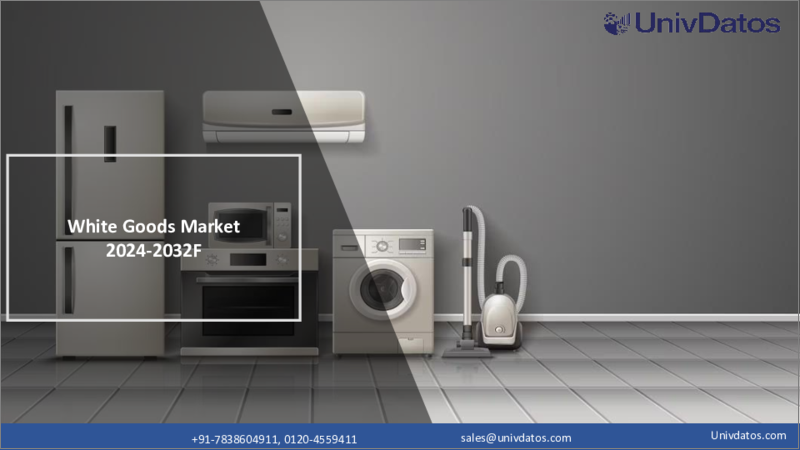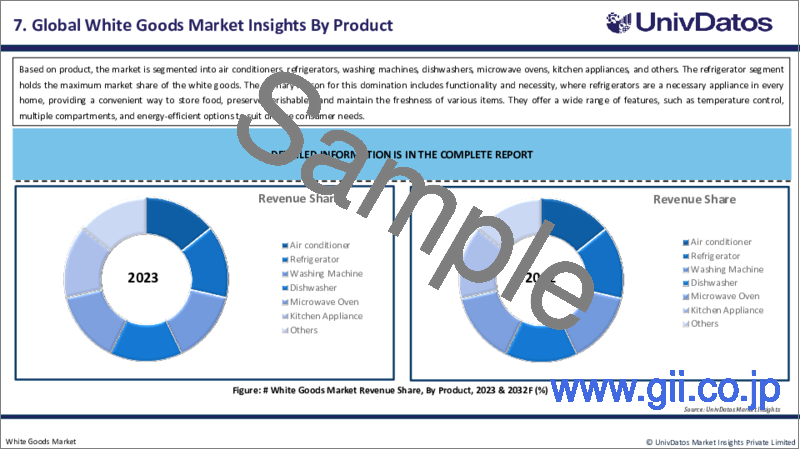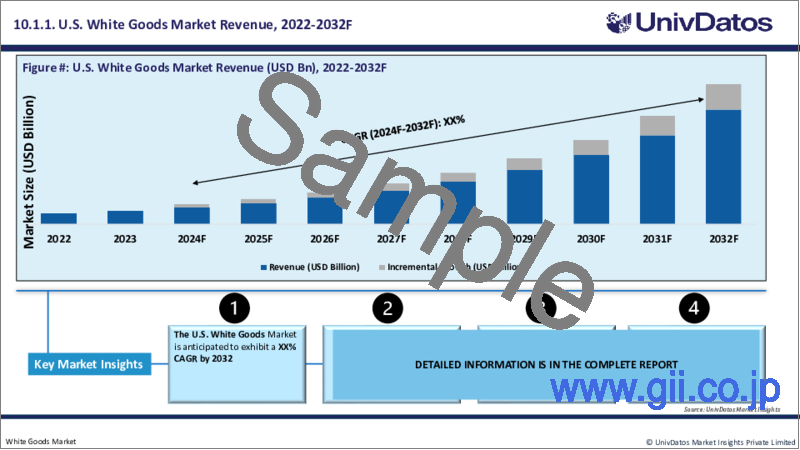|
|
市場調査レポート
商品コード
1408716
白物家電市場:現状分析と予測(2023-2030年)White Goods Market: Current Analysis and Forecast (2023-2030) |
||||||
カスタマイズ可能
|
|||||||
| 白物家電市場:現状分析と予測(2023-2030年) |
|
出版日: 2023年12月30日
発行: UnivDatos Market Insights Pvt Ltd
ページ情報: 英文 156 Pages
納期: 即日から翌営業日
|
全表示
- 概要
- 目次
白物家電市場は、人口増加と都市化により、CAGR約7.54%の高成長が見込まれています。また、新興国を中心とした所得水準の上昇により、消費者の購買力が高まり、白物家電の需要が増加しています。さらに、白物家電業界における継続的な技術革新により、よりエネルギー効率が高く、スマートで使いやすい家電製品が登場し、消費者の既存機器のアップグレードを誘引していることも、市場における白物家電の需要をさらに加速させています。さらに、国境を越えた取引が容易になり、eコマースプラットフォームが成長したことで、消費者はさまざまなメーカーの幅広い白物家電にアクセスしやすくなり、選択肢が広がって需要を促進していることも、市場における白物家電の需要を促進している主な要因です。例えば、国際貿易協会(ITA)によると、中国はオンラインチャネル経由の総売上高のほぼ50%を占めており、オンライン売上高の合計は2022年に3兆3,000億米ドルの大台を超えます。米国は中国に次いで世界第2位のeコマース市場です。
市場は製品別に、エアコン、冷蔵庫、洗濯機、食器洗い機、電子レンジ、キッチン家電、その他に区分されます。白物家電では、冷蔵庫が最大のシェアを占めています。冷蔵庫はどの家庭にも必要な家電製品であり、食品を保存し、生鮮食品を保存し、さまざまなもの鮮度を保つのに便利です。冷蔵庫は、多様な消費者ニーズに対応するため、温度調節、複数のコンパートメント、エネルギー効率の高いオプションなど、幅広い機能を提供しています。さらに、世界の人口増加、都市化、消費者のライフスタイルの変化が、冷蔵庫の需要増加につながっています。家庭が狭くなり、忙しくなるにつれて、個人は食品を大量に保存することを好むようになり、広くて技術的に進んだ冷蔵ソリューションへのニーズが高まっています。これに加えて、冷蔵庫業界は近年著しい技術進歩を遂げています。Wi-Fi接続、タッチスクリーン、省エネオプションなどの機能を備えたスマート冷蔵庫のイントロダクションが需要をさらに促進しています。消費者はますます利便性とエネルギー効率を優先するようになり、先進モデルの採用を促進しています。例えば、2023年1月、サムスン電子はカスタマイズ可能なビスポーク・ホームのラインナップを発表しました。これらの最新家電製品は、消費者から寄せられるカスタマイズ需要の高まりに応えるためにサムスンが設計したものです。ビスポーク冷蔵庫は、4つのドアすべてに32インチの大型スクリーンを搭載し、AI機能を備えています。
エンドユーザーに基づき、市場は住宅用と商業用に二分されます。住宅用セグメントが市場シェアの大半を占めています。この高い市場シェアの主な要因には、人口増加と都市化が含まれます。都市化の進展とともに世界人口が増加していることが、住宅用耐久消費財市場の優位性を支える主な要因となっています。より多くの世帯が設立され、都市部が拡大するにつれて、住宅用電化製品や耐久消費財の需要が拡大します。さらに、社会規範の変化やライフスタイル動向の変化は、耐久消費財業界に大きな影響を与えています。現代のライフスタイルは、可処分所得の増加と相まって、タスクを簡素化し日常業務を合理化する先進技術や製品への投資を住宅所有者に促しています。このような快適性と利便性の絶え間ない追求は、耐久消費財に対する消費者の強い嗜好を表しています。
流通チャネル別に見ると、市場はオンライン小売とオフライン小売に二分されます。オンライン小売は著しい成長を遂げており、最も急成長している流通チャネルです。白物家電におけるオンライン小売の急成長の主な要因の一つは、消費者に利便性を提供することです。数回クリックするだけで、自宅にいながらにして膨大な数の商品を閲覧し、価格を比較し、レビューを読み、購入することができます。オンライン小売の成長を促進するもう一つの要因は、より広いリーチを提供することです。実店舗とは異なり、オンライン・プラットフォームでは、地理的な境界を乗り越え、世界中の顧客に対応することができます。このようなアクセシビリティの向上が、企業のオンラインプレゼンス拡大を促し、白物家電の売上増につながっています。さらに、テクノロジーの進歩は、シームレスなオンライン・ショッピング体験への道を開いた。eコマース・プラットフォームはよりユーザーフレンドリーになり、パーソナライズされたレコメンデーションや安全な決済ゲートウェイなどの機能を提供しています。こうした技術の進歩は消費者に信頼を与え、オンライン・ショッピングの普及につながっています。最後に、ロジスティクスと配送システムの継続的な改善も、オンライン小売の需要拡大に道を開く分野です。当日配送や翌日配送など、より迅速で効率的な配送サービスは、顧客満足度を大幅に高め、オンライン販売の成長を後押ししています。さらに、サードパーティ・ロジスティクス・プロバイダーの出現により、サプライチェーンがさらに合理化され、オンライン小売は耐久消費財の購入においてさらに魅力的な選択肢となっています。
白物家電の市場導入に関する理解を深めるため、市場は北米(米国、カナダ、その他北米地域)、欧州(ドイツ、英国、フランス、スペイン、イタリア、その他欧州地域)、アジア太平洋地域(中国、日本、インド、その他アジア太平洋地域)、世界のその他の地域における世界のプレゼンスに基づいて分析されています。近年、アジア太平洋地域は白物家電市場において最も急成長している地域となっています。この高成長環境を生み出している要因はいくつかあります。主な要因のひとつは急速な都市化であり、アジア太平洋諸国の都市中心部の拡大が可処分所得の増加につながり、白物家電に対する需要の急増を生み出しています。人々が都市部に移り住むにつれて、家庭用の電化製品や電子機器を求めるようになり、これが市場の成長を刺激しています。さらに、アジア太平洋地域における中流階級の人口増加は、白物家電の成長に大きな影響を与えています。より多くの個人が生活水準を上げ、より良い収入を得られるようになったことで、冷蔵庫、テレビ、エアコン、洗濯機などの製品に対する需要が非常に高まっています。また、eコマース・プラットフォームの急成長は、消費者の耐久消費財購入方法に革命をもたらしました。オンライン小売業者が提供する利便性、アクセスしやすさ、競争力のある価格設定が、この地域での需要拡大に大きな役割を果たしています。さらに、アジア太平洋地域では、住宅や商業プロジェクトなどのインフラ整備に多額の投資が行われています。このため、白物家電.NETの需要が大きく伸びています。
目次
第1章 市場イントロダクション
- 市場の定義
- 主な目標
- ステークホルダー
- 制限事項
第2章 調査手法または前提
- 調査プロセス
- 調査手法
- 回答者プロファイル
第3章 市場要約
第4章 エグゼクティブサマリー
第5章 COVID-19が白物家電市場に与える影響
第6章 白物家電市場収益、2020-2030年
第7章 製品別の市場洞察
- エアコン
- 冷蔵庫
- 洗濯機
- 食器洗い機
- 電子レンジ
- キッチン家電
- その他
第8章 エンドユーザー別市場洞察
- 住宅
- 商業
第9章 流通チャネル別の市場洞察
- オンライン小売
- オフライン小売
第10章 地域別の市場洞察
- 北米
- 米国
- カナダ
- その他北米地域
- 欧州
- ドイツ
- 英国
- フランス
- イタリア
- スペイン
- その他欧州地域
- アジア太平洋
- 中国
- インド
- 日本
- 韓国
- その他アジア太平洋地域
- 世界のその他の地域
第11章 白物家電市場力学
- 市場促進要因
- 市場の課題
- 影響分析
第12章 白物家電市場機会
第13章 白物家電市場動向
第14章 需要側と供給側の分析
- 需要側分析
- 供給側分析
第15章 バリューチェーン分析
第16章 競合シナリオ
- 競合情勢
- ポーターのファイブフォース分析
第17章 企業プロファイル
- Whirlpool Corporation
- Jhonson Controls
- IFB Industries Limited.
- Panasonic Industry Co., Ltd.
- Godrej & Boyce Mfg. Co. Ltd.
- SAMSUNG
- DAIKIN INDUSTRIES, Ltd.,
- Hitachi, Ltd
- LG Electronics
- Haier Group
第18章 免責事項
White goods refer to large household appliances that are typically finished in white or light-colored materials. These appliances are designed for various domestic purposes, primarily in the kitchen and laundry areas, to support everyday tasks and improve the overall efficiency and convenience of household operations. White goods are called so due to their traditional white or light-colored exterior finishes. However, in modern times, it is common to find these appliances in various colors and finishes to match different kitchen or laundry aesthetics.
The White Goods Market is expected to grow at a strong CAGR of around 7.54% owing to the growing population and urbanization. Furthermore, the rising income levels, particularly in emerging economies, have led to higher purchasing power for consumers, resulting in increased demand for white goods. Additionally, continuous technological innovations in the white goods industry have introduced more energy-efficient, smart, and user-friendly appliances, enticing consumers to upgrade their existing equipment is further accelerating the demand for the white goods in the market. Moreover, the ease of cross-border trade and the growth of e-commerce platforms have made it simpler for consumers to access a wide range of white goods from different manufacturers, expanding their choices and driving demand are also the major factors that are driving the demand for white goods in the market. For instance, as per the International Trade Association (ITA), China accounts for almost 50% of the total sales through online channels, with total online sales crossing the USD 3.3 trillion mark in the year 2022. After China, the USA is the second largest e-commerce market globally.
Based on product, the market is segmented into air conditioners, refrigerators, washing machines, dishwashers, microwave ovens, kitchen appliances, and others. The refrigerator segment holds the maximum market share of the white goods. The primary reason for this domination includes functionality and necessity, where refrigerators are a necessary appliance in every home, providing a convenient way to store food, preserve perishables, and maintain the freshness of various items. They offer a wide range of features, such as temperature control, multiple compartments, and energy-efficient options to suit diverse consumer needs. Furthermore, the growing global population, urbanization, and changing consumer lifestyles have contributed to increased demand for refrigerators. As households become smaller and busier, individuals prefer storing food in larger quantities, leading to an increased need for spacious and technologically advanced refrigeration solutions. In addition to this, the refrigerator industry has witnessed significant technological advancements in recent years. The introduction of smart refrigerators with features like Wi-Fi connectivity, touch screens, and energy-saving options has further fueled demand. Consumers increasingly prioritize convenience and energy efficiency, driving the adoption of advanced models, which can also be witnessed from the product launches that are happening in this space. For instance, in January 2023, Samsung Electronics unveiled its customizable Bespoke Home lineup, These latest home appliances are designed by Samsung to meet the growing customization demands that are coming from consumers. The Bespoke refrigerator types are equipped with large and immersive 32-inch screens on all four doors and with AI capabilities.
Based on end-user, the market is bifurcated into residential and commercial. The residential segment holds the majority of the market share. The primary factors that are responsible for this high market share include growing population and urbanization, the rising growth of the global population, along with increasing urbanization, is a major factor backing the residential consumer durables market's dominance. As more households are established and urban areas expand, the demand for residential appliances and durable goods escalates. Furthermore, shifting societal norms and changing lifestyle trends have a significant impact on the consumer durables industry. Modern lifestyles, coupled with increasing disposable incomes, encourage homeowners to invest in advanced technologies and products that simplify tasks and streamline daily routines. This constant pursuit of comfort and convenience portrays a strong consumer preference for residential consumer durables.
Based on the distribution channel, the market is bifurcated into online and offline retail. Online retail is witnessing tremendous growth and is the fastest-growing distribution channel. One of the key factors contributing to the rapid growth of online retail in white goods is the convenience it offers to consumers. With just a few clicks, individuals can browse through a vast array of products, compare prices, read reviews, and make purchases from the comfort of their homes. Another factor driving the growth of online retail is the wider reach it provides. Unlike physical stores, online platforms enable businesses to overcome geographical boundaries and cater to customers worldwide. This enhanced accessibility has encouraged businesses to expand their online presence, resulting in increased sales of white goods. Additionally, the advancements in technology have paved the way for a seamless online shopping experience. E-commerce platforms have become more user-friendly, offering features such as personalized recommendations and secure payment gateways. These technological advancements have instilled confidence in consumers, leading to a higher adoption of online shopping. Lastly, the continuous improvement of logistics and delivery systems is another area that paves the way for increased demand in online retail. Faster and more efficient delivery services, such as same-day or next-day delivery, have significantly enhanced customer satisfaction and propelled the growth of online sales. Additionally, the emergence of third-party logistics providers has further streamlined the supply chain, making online retail an even more enticing option for purchasing consumer durables.
For a better understanding of the market adoption of white goods, the market is analyzed based on its worldwide presence in countries such as North America (The U.S., Canada, and the Rest of North America), Europe (Germany, The U.K., France, Spain, Italy, Rest of Europe), Asia-Pacific (China, Japan, India, Rest of Asia-Pacific), Rest of World. In recent years, Asia Pacific is emerged as the fastest-growing region for white goods in the market. Several factors are contributing to creating this high-growth environment for the region. One of the major factors is rapid urbanization, where the expanding urban centers in Asia Pacific countries have led to an increase in disposable income, creating a surge in demand for white goods. As people move to urban areas, they seek appliances, and electronics for their homes, which has stimulated market growth. Furthermore, the rising middle-class population in the Asia Pacific region has had a substantial impact on the growth of white goods. As more individuals elevate their living standards and gain access to better incomes, there is a tremendous demand for products like refrigerators, televisions, air conditioners, and washing machines. Additionally, the rapid growth of e-commerce platforms has revolutionized the way consumers purchase consumer durables. The convenience, accessibility, and competitive pricing offered by online retailers have played a significant role in escalating demand in the region. Moreover, the Asia Pacific region is witnessing substantial investments in infrastructure development, including housing and commercial projects. This creates a significant demand for white goods.
Some of the major players operating in the market include: Whirlpool Corporation; Jhonson Controls; IFB Industries Limited.; Panasonic Industry Co., Ltd.; Godrej & Boyce Mfg. Co. Ltd.; SAMSUNG; DAIKIN INDUSTRIES, Ltd.,; Hitachi, Ltd; LG Electronics; and Haier Group
TABLE OF CONTENTS
1 MARKET INTRODUCTION
- 1.1. Market Definitions
- 1.2. Main Objective
- 1.3. Stakeholders
- 1.4. Limitation
2 RESEARCH METHODOLOGY OR ASSUMPTION
- 2.1. Research Process of the White Goods Market
- 2.2. Research Methodology of the White Goods Market
- 2.3. Respondent Profile
3 MARKET SYNOPSIS
4 EXECUTIVE SUMMARY
5 IMPACT OF COVID-19 ON THE WHITE GOODS MARKET
6 WHITE GOODS MARKET REVENUE (USD BN), 2020-2030F.
7 MARKET INSIGHTS BY PRODUCT
- 7.1. Air conditioner
- 7.2. Refrigerator
- 7.3. Washing Machine
- 7.4. Dishwasher
- 7.5. Microwave Oven
- 7.6. Kitchen Appliance
- 7.7. Others
8 MARKET INSIGHTS BY END-USER
- 8.1. Residential
- 8.2. Commercial
9 MARKET INSIGHTS BY DISTRIBUTION CHANNEL
- 9.1. Online Retail
- 9.2. Offline Retail
10 MARKET INSIGHTS BY REGION
- 10.1. North America
- 10.1.1. The U.S.
- 10.1.2. Canada
- 10.1.3. Rest of North America
- 10.2. Europe
- 10.2.1. Germany
- 10.2.2. The U.K.
- 10.2.3. France
- 10.2.4. Italy
- 10.2.5. Spain
- 10.2.6. Rest of Europe
- 10.3. Asia-Pacific
- 10.3.1. China
- 10.3.2. India
- 10.3.3. Japan
- 10.3.4. South Korea
- 10.3.5. Rest of Asia-Pacific
- 10.4. Rest of the World
11 WHITE GOODS MARKET DYNAMICS
- 11.1. Market Drivers
- 11.2. Market Challenges
- 11.3. Impact Analysis
12 WHITE GOODS MARKET OPPORTUNITIES
13 WHITE GOODS MARKET TRENDS
14 DEMAND AND SUPPLY-SIDE ANALYSIS
- 14.1. Demand Side Analysis
- 14.2. Supply Side Analysis
15 VALUE CHAIN ANALYSIS
16 COMPETITIVE SCENARIO
- 16.1. Competitive Landscape
- 16.1.1. Porters Fiver Forces Analysis
17 COMPANY PROFILED
- 17.1. Whirlpool Corporation
- 17.2. Jhonson Controls
- 17.3. IFB Industries Limited.
- 17.4. Panasonic Industry Co., Ltd.
- 17.5. Godrej & Boyce Mfg. Co. Ltd.
- 17.6. SAMSUNG
- 17.7. DAIKIN INDUSTRIES, Ltd.,
- 17.8. Hitachi, Ltd
- 17.9. LG Electronics
- 17.10. Haier Group





